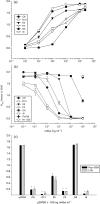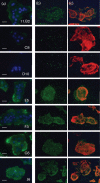Binding and neutralization characteristics of a panel of monoclonal antibodies to human papillomavirus 58
- PMID: 20181746
- PMCID: PMC3052528
- DOI: 10.1099/vir.0.017228-0
Binding and neutralization characteristics of a panel of monoclonal antibodies to human papillomavirus 58
Abstract
Human papillomavirus (HPV) 58 is a high-risk HPV type associated with progression to invasive genital carcinomas. We developed six monoclonal antibodies (mAbs) against HPV58 L1 virus-like particles that bind conformational epitopes on HPV58. The hybridoma cell lines were adapted to serum- and animal component-free conditions and the mAb supernatants were affinity-purified. The six mAbs neutralized HPV58 pseudoviruses (PsVs) and 'quasivirions' with different capacities. The mAbs differed in their ability to prevent PsV58 attachment to HaCaT cells, to the extracellular matrix (ECM) deposited by HaCaT cells, to heparin and to purified human laminin 5, a protein in the ECM. These mAbs provide a unique set of tools to study the binding properties of a previously untested, high-risk HPV type and the opportunity to compare these characteristics with the binding of other HPV types.
Figures


Similar articles
-
Comprehensive Assessment of the Antigenic Impact of Human Papillomavirus Lineage Variation on Recognition by Neutralizing Monoclonal Antibodies Raised against Lineage A Major Capsid Proteins of Vaccine-Related Genotypes.J Virol. 2020 Nov 23;94(24):e01236-20. doi: 10.1128/JVI.01236-20. Print 2020 Nov 23. J Virol. 2020. PMID: 32967963 Free PMC article.
-
Reactivity pattern of 92 monoclonal antibodies with 15 human papillomavirus types.J Gen Virol. 2008 Jan;89(Pt 1):117-129. doi: 10.1099/vir.0.83145-0. J Gen Virol. 2008. PMID: 18089735
-
Epitope Mapping of Neutralizing Monoclonal Antibodies to Human Interferon-γ Using Human-Bovine Interferon-γ Chimeras.J Interferon Cytokine Res. 2016 Sep;36(9):542-51. doi: 10.1089/jir.2016.0017. Epub 2016 Jun 23. J Interferon Cytokine Res. 2016. PMID: 27336613 Free PMC article.
-
Development of a human papillomavirus competitive luminex immunoassay for 9 HPV types.Hum Vaccin Immunother. 2014;10(8):2168-74. doi: 10.4161/hv.29205. Hum Vaccin Immunother. 2014. PMID: 25424920 Free PMC article. Review.
-
Functional assessment and structural basis of antibody binding to human papillomavirus capsid.Rev Med Virol. 2016 Mar;26(2):115-28. doi: 10.1002/rmv.1867. Epub 2015 Dec 17. Rev Med Virol. 2016. PMID: 26676802 Review.
Cited by
-
Monoclonal Antibodies to S and N SARS-CoV-2 Proteins as Probes to Assess Structural and Antigenic Properties of Coronaviruses.Viruses. 2021 Sep 22;13(10):1899. doi: 10.3390/v13101899. Viruses. 2021. PMID: 34696329 Free PMC article.
-
A cryo-electron microscopy study identifies the complete H16.V5 epitope and reveals global conformational changes initiated by binding of the neutralizing antibody fragment.J Virol. 2015 Jan 15;89(2):1428-38. doi: 10.1128/JVI.02898-14. Epub 2014 Nov 12. J Virol. 2015. PMID: 25392224 Free PMC article.
-
Adaptation-proof SARS-CoV-2 vaccine design.Adv Funct Mater. 2022 Dec 2;32(49):2206055. doi: 10.1002/adfm.202206055. Epub 2022 Oct 3. Adv Funct Mater. 2022. PMID: 36590650 Free PMC article.
-
HPV pseudovirions as DNA delivery vehicles.Ther Deliv. 2011 Apr;2(4):427-30. doi: 10.4155/tde.11.28. Ther Deliv. 2011. PMID: 21709779 Free PMC article.
-
SP-R210 (Myo18A) Isoforms as Intrinsic Modulators of Macrophage Priming and Activation.PLoS One. 2015 May 12;10(5):e0126576. doi: 10.1371/journal.pone.0126576. eCollection 2015. PLoS One. 2015. PMID: 25965346 Free PMC article.
References
-
- Bhatla, N., Lal, N., Bao, Y. P., Ng, T. & Qiao, Y. L. (2008). A meta-analysis of human papillomavirus type distribution in women from South Asia: implications for vaccination. Vaccine 26, 2811–2817. - PubMed
-
- Chan, P. K. S., Mak, K. H., Cheung, J. L. K., Tang, N. L. S., Chan, D. P. C., Lo, K. K. & Cheng, A. F. (2002). Genotype spectrum of cervical human papillomavirus infection among sexually transmitted disease clinic patients in Hong Kong. J Med Virol 68, 273–277. - PubMed
-
- Christensen, N. D., Kreider, J. W., Cladel, N. M. & Galloway, D. A. (1990). Immunological cross-reactivity to laboratory-produced HPV-11 virions of polysera raised against bacterially derived fusion proteins and synthetic peptides of HPV-6B and HPV-16 capsid proteins. Virology 175, 1–9. - PubMed
Publication types
MeSH terms
Substances
Grants and funding
LinkOut - more resources
Full Text Sources

